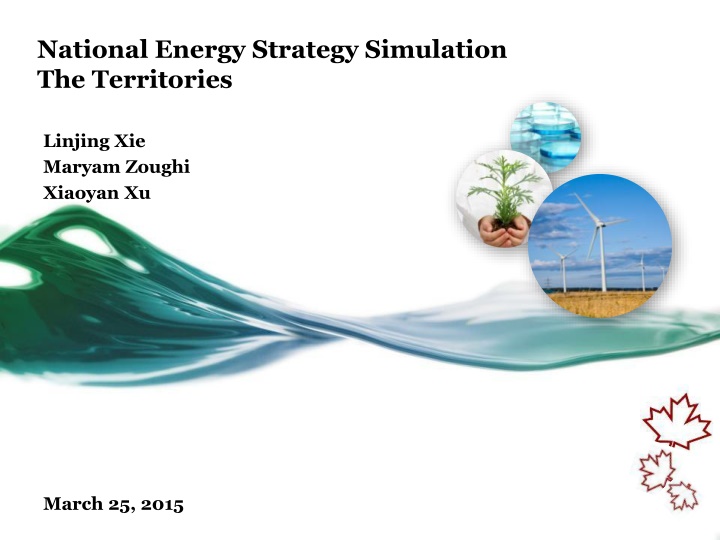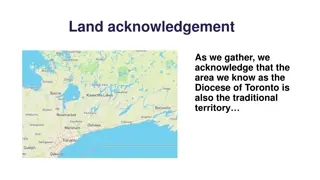National Energy Strategy Simulation: Addressing Energy Challenges in the Territories
This comprehensive report assesses the weaknesses and missed opportunities in energy policy in the territories, focusing on issues such as expensive heating costs, insufficient energy supply, and aggressive promotion of oil and gas development. It also delves into the challenges and opportunities related to oil sands, gas market access, climate policy issues, and renewable energy potentials in the region.
Download Presentation

Please find below an Image/Link to download the presentation.
The content on the website is provided AS IS for your information and personal use only. It may not be sold, licensed, or shared on other websites without obtaining consent from the author.If you encounter any issues during the download, it is possible that the publisher has removed the file from their server.
You are allowed to download the files provided on this website for personal or commercial use, subject to the condition that they are used lawfully. All files are the property of their respective owners.
The content on the website is provided AS IS for your information and personal use only. It may not be sold, licensed, or shared on other websites without obtaining consent from the author.
E N D
Presentation Transcript
National Energy Strategy Simulation The Territories Linjing Xie Maryam Zoughi Xiaoyan Xu March 25, 2015
Weaknesses and Missed Opportunities in Energy Policy Expensive heating and electricity cost Insufficient energy supply Aggressively promoting oil & gas development and mining activity No or small territory-wide targets for reducing GHG emissions R & D: Inappropriate renewable energy established Little progress on a territory-wide building code for energy efficiency National Energy Strategy Simulation: The Territories 3/25/2015 1
Oil Sands/Oil & Gas Market Access National/International Pipeline: Canol Road; shale oil production Pipeline: Oil sands from Alberta to Tuktoyaktuk (NWT) A 2,400-kilometre-long railway: Fort McMurray to the Trans-Alaska Mackenzie NG pipeline: NG from the Beaufort Sea to tie into gas pipelines in northern Alberta Pipeline Territorial Amauligak oil and gas field in the Mackenzie Valley Delta and Beaufort Sea Domestic refineries Feasibility assessment of liquefied natural gas (LNG) First Nation opposition to the rapid expansion of oil sands development National Energy Strategy Simulation: The Territories 3/25/2015 2
Climate Policy Issues: Thawing permafrost, changing sea ice patterns, reduction in sea ice thickness and cover, rising sea levels and temperature, melting glaciers and extreme or unexpected weather events (Source: The Pan-Territorial Adaptation Strategy, 2011) National: Regulations/policies restricting GHG emissions for each provinces Initial positions: Provincial: Collaboration with other provinces in monitoring, assessing and predicting the impacts of climate change Territorial: Collaboration of territorial governments to work together on climate change Partnership between first nation and territorial research centre to inventorying energy and GHG emissions Source: https://www.ec.gc.c a/indicateurs- indicators/default.a sp?lang=en&n=18F 3BB9C-1 National Energy Strategy Simulation: The Territories 3/25/2015 3
Renewable Energy High hydro potential, especially mini-hydro (run-of-river) potential Wind power potential Demand for more reliable and less expensive energy service Northwest Territories Proposed Taltson expansion; Mini-hydro for communities; Extension of the existing hydro grid Snare hydro near Yellowknife, and the Talston hydro dam near Fort Smith The Hamlet of Tuktoyaktuk in the Northwest Territories is promoting a regional hub-and-spoke model based on the Alaskan experience The wind-diesel hybrid systems in the Beaufort region is under planning Yukon 3 established hydro plants with the ability to generate 75 MW The largest wind turbines in the North stand prominently on Haeckel Hill near Whitehorse in Yukon. These turbines have an installed capacity of 800 kW and have been operating since the 1990s Nunavut Assessments of hydroelectric potential have been completed for various locations near Iqaluit and in the Kivalliq region The Nunavut power utility company, Qulliq Energy Corporation, is working toward installing a wind-hydrogen-diesel generation plant in Cape Dorset 3 wind projects have been attempted National Energy Strategy Simulation: The Territories 3/25/2015 4
Conclusion Cost Effectiveness Environmental Effectiveness Supply Sufficiency Social Acceptability Total Score Criteria Alternatives EE & Conservation 20% increase by 2020 +1 +1 +1 +1 +4 Hydro, wind Power 20% increase by 2020 -1 +1 +1 +1 +2 R&D: Renewable energy technologies, Environmental impacts -1 +1 +1 +1 +2 Energy storage & backup 0 +1 +1 0 +2 Hybrid cap & trade- Carbon neutral operations by 2020 +1 +1 0 -1 +1 Oil sand & NG pipelines, Refineries +1 -1 +1 -1 0 National Energy Strategy Simulation: The Territories 3/25/2015 5
Thank you! Questions? National Energy Strategy Simulation: The Territories 3/25/2015 6
Resources National Energy Strategy Simulation: The Territories 3/25/2015 7
Energy Supply 100% 90% 80% 70% 60% 50% 40% NWT Yukon 30% 20% 10% 0% Hydro Diesel NG Wind & Solar Oil & NG Biomass Propane/ other Electricity Generation Heat Generation Nunavut: 100% fossil fuel for heat and electricity generation National Energy Strategy Simulation: The Territories 8 3/25/2015























